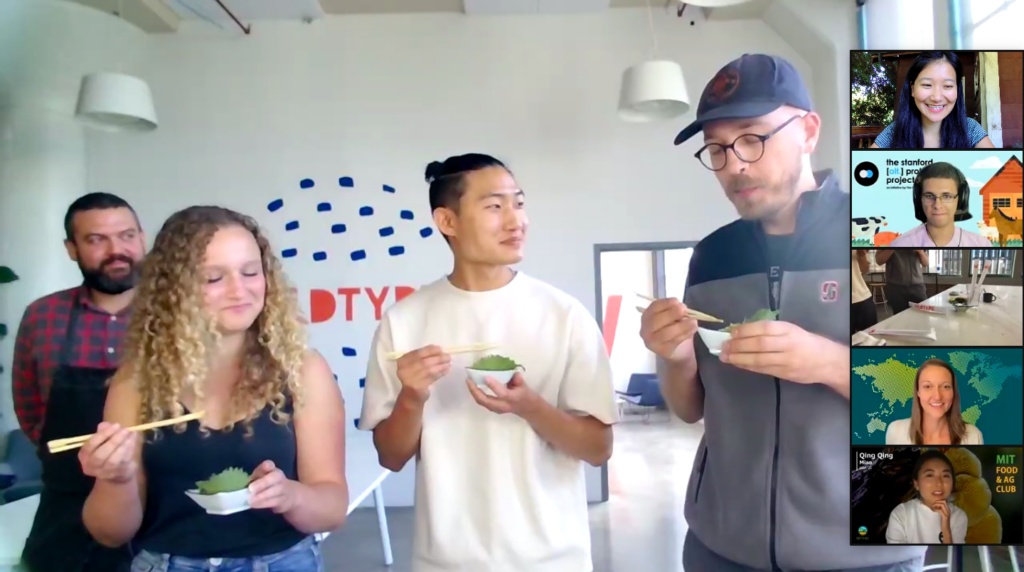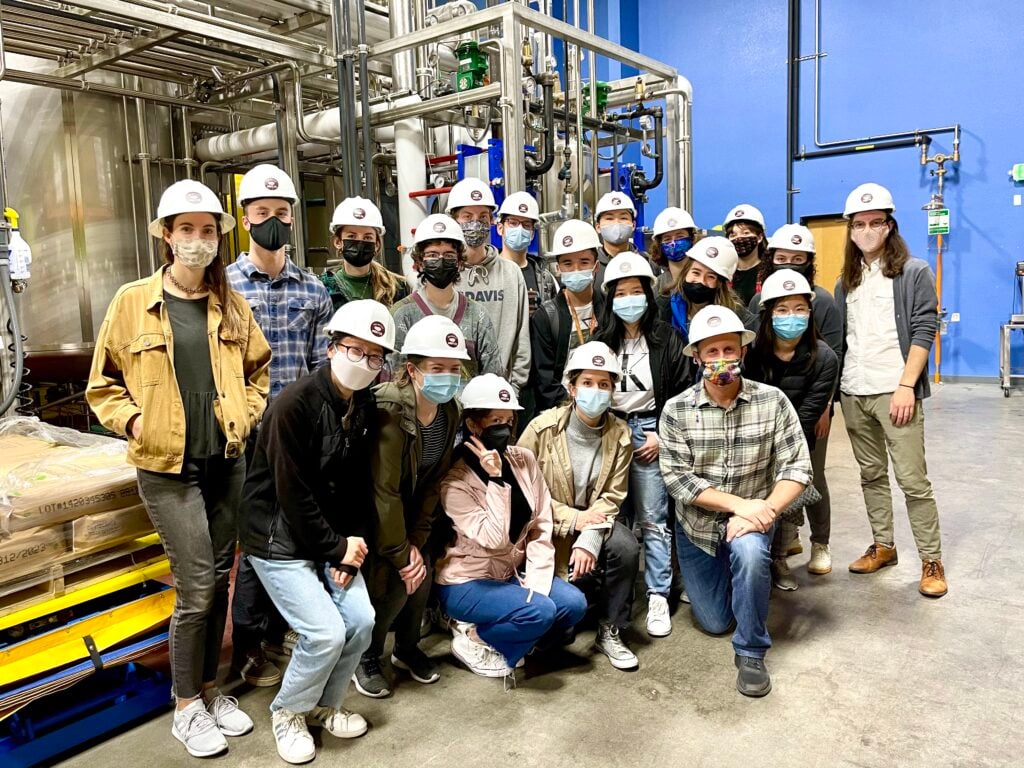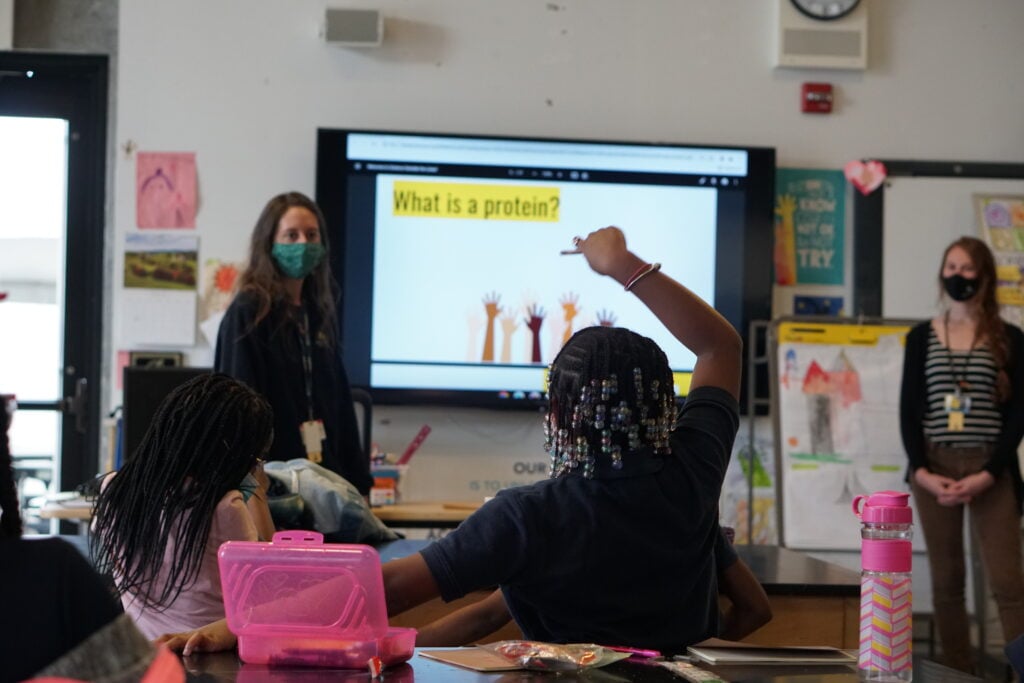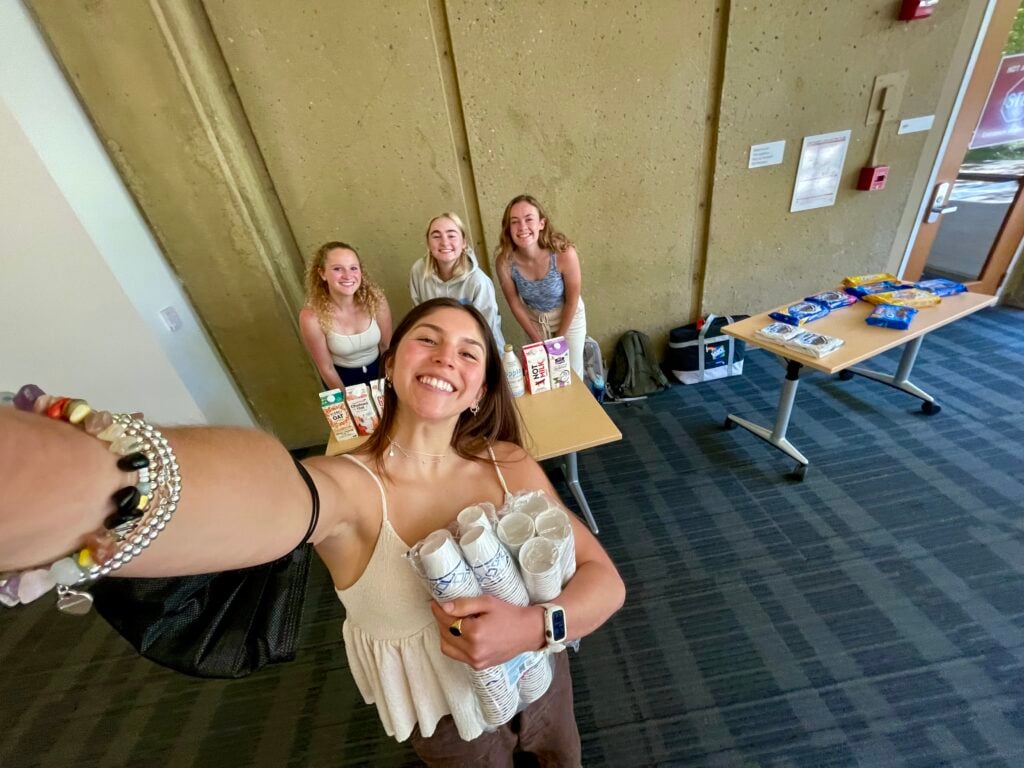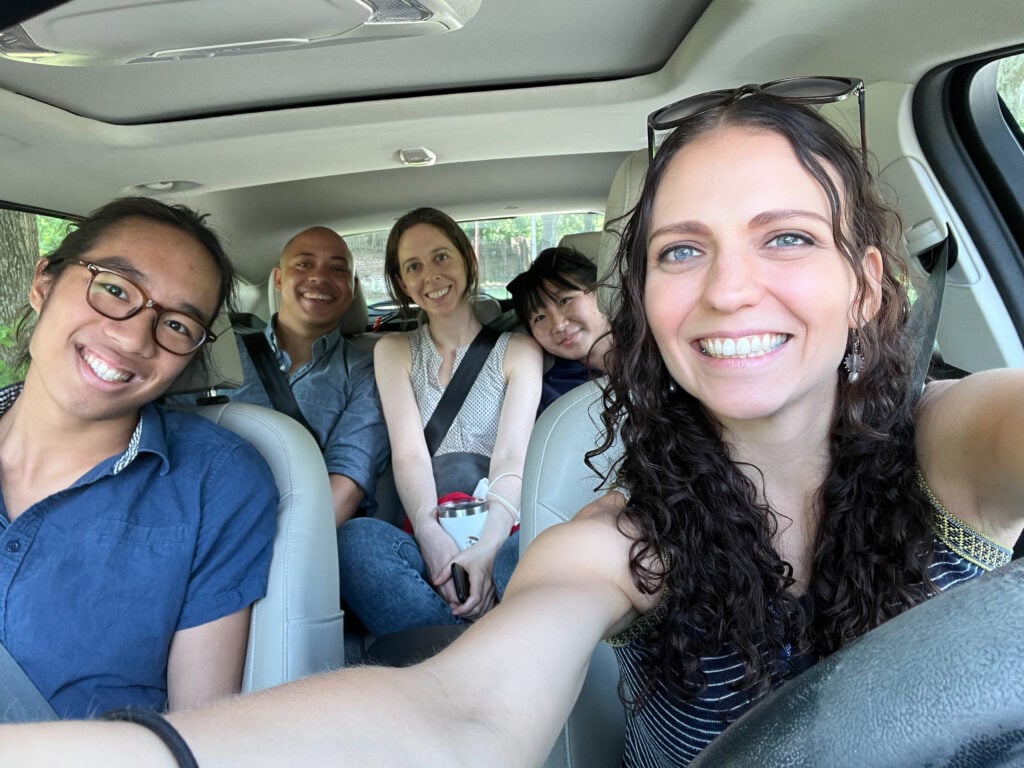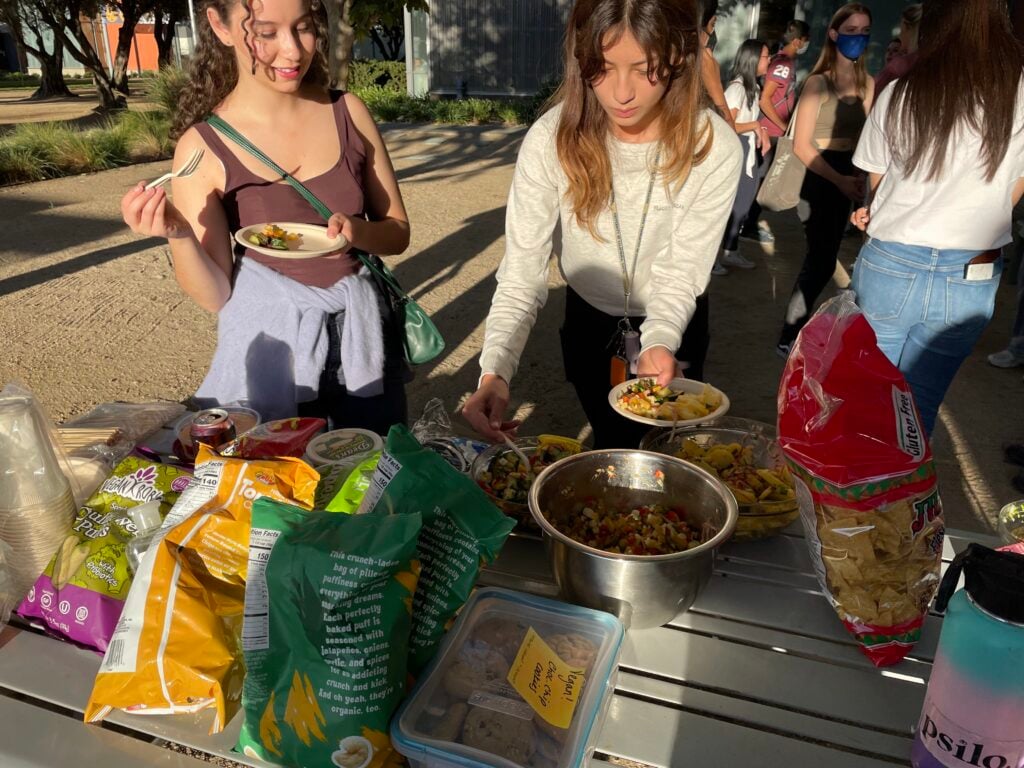
Creating an inspiring, inclusive community
When it comes to accelerating novel technologies or entering an emerging field like alternative proteins, a community of practice can make all the difference. This guide will help you build and sustain an inclusive, vibrant, and long-lasting alternative protein community for students and researchers.
Introduction to communities of practice
The importance of practice-based communities
What are communities of practice?
A community provides social connection and a sense of belonging. Communities are often based on location or interest, like a local cafe or fantasy football league. While many student organizations center around places or hobbies, Alt Protein Project groups are best categorized as communities of practice.
A practice-based community is a group of people who “share a concern or a passion for something they do and learn how to do it better as they interact regularly” (Wenger-Trayner et al. 2015). If your student group aspires to build the alternative protein movement on campus, we recommend taking a close look at this framework to understand its value to the growing field of alternative proteins.
Why they’re important
Communities of practice are game-changing for emerging technologies, which face two obstacles to widespread acceptance and integration. First, we need to advance the technology itself. Solving this challenge requires people—specifically researchers and innovators with specialized skill sets. However, nascent fields often lack formal structures that enable people to enter the field, like degree programs and professional societies. So the second obstacle is to develop these structures—in other words, to build the field itself.
It can take years to establish formal programs like courses and apprenticeships. Luckily, these are not the only legitimate forms of education. Knowledge-sharing often takes place in study groups, online forums, and other informal structures. When these spaces are nurtured and legitimized, training can be accelerated in a new technology area, even if the field is still being developed.
Communities of practice adopt formal and informal approaches to learning and problem-solving. Understanding these communities lets us appreciate and leverage the value of peer-to-peer learning and other informal ways to share knowledge. When there’s a range of educational pathways, community members have more opportunities to advance the emerging technology or contribute to field-building. When strong, welcoming communities of practice are created, we grow closer and accomplish more together than we ever could on our own. Take a look at the APP impact page for a few inspiring examples.
Why they’re useful for the alternative protein field
We consider alternative proteins to be an emerging field because it draws from multiple parent disciplines to address a previously neglected problem. The alternative protein field utilizes these key disciplines to produce meat more sustainably and efficiently.
As courses and degree programs are just being established, the alternative protein space can sometimes feel daunting to navigate alone. This stage is where communities of practice are indispensable. The absence of a pre-existing structure means we can embrace the chance to create more engaging, inclusive, and effective methods of learning and developing professionally.
Ideal community of practice
Specialized researchers and field-builders
To serve as a community of practice for advancing alternative proteins on campus, your membership should include specialized researchers and field-builders. Members can certainly fall into both categories or flow from one to another, but each individual should be able to participate in at least one group.
- Specialized researchers. These are researchers in the key disciplines who solve technological challenges in alternative protein science and engineering. These members likely include university faculty, postdoctoral researchers, PhD students, highly-focused master’s students, and undergraduate researchers.
- Field-builders. These individuals build initiatives to increase student participation in alternative protein research, education, and innovation on campus. Advocacy and mobilization is a much-needed skill and those roles are great ways for motivated individuals outside life sciences and natural sciences to lend their hands in shaping the alternative protein community.
Both groups are essential
For many specialized researchers in a practice-based community, the long-term goal is to produce open-access information to help advance the entire alternative protein field. In the short term, these individuals are well-positioned to identify common research challenges and build collaborative research teams. They can also help guide prospective researchers towards white spaces that align with their skills and interests.
On the other hand, field-builders aim to channel more people into alternative protein research and careers. Their short-term goals may include equipping students with resources for getting started in the field, providing low-stakes opportunities to ask and explore questions, and organizing events focused on alternative proteins.
In the ideal community of practice, the two membership categories overlap and work in close collaboration. For example, specialized researchers act as field-builders when supporting outreach activities; or an undergraduate student might join the movement in a field-building capacity and then become a specialized researcher in graduate school.
The ideal make up of practice-based communities
Communities of practice provide a collaborative space for a range of activities related to knowledge-sharing and project coordination. Adapted from Introduction to communities of practice by Etienne and Beverly Wenger-Trayner, this table offers examples of how members can seek and provide support with research and field-building.
| Activity | Example |
|---|---|
| Problem solving | “How can we scale up this fermentation process for commercial production of alternative proteins?” |
| Requests for information | “Where can I find cell lines relevant to cultivated seafood?” |
| Seeking experience | “Does anyone have advice on following up with busy faculty members?” |
| Reusing assets | “We submitted a research proposal for this program last year; let me send you the file so you don’t have to start from scratch.” |
| Coordination and strategy | “This other student group would be interested in hearing from this guest speaker as well. Can we co-host the event with them and increase turnout?” |
| Building an argument | “How have other student groups convinced their university administrators to fund alternative protein courses and research?” |
| Growing confidence | “Before we commit to a monthly career seminar series, let’s survey our membership to gauge interest.” |
| Discussing developments | “What do you think of this new approach to producing serum-free media for cultivated meat?” |
| Documenting projects | “It’s never easy to find a meeting space. Let’s create a guide for next year’s leadership team.” |
| Visits | “Let’s organize a tour of a local alternative protein company.” |
| Mapping knowledge and identifying gaps | “Are there any on-campus researchers with relevant experience in alternative proteins? Who should we reach out to?” |
No single person contains the experience and expertise to answer all of these questions, which is why a collaborative community is such a strong impact multiplier. Student leaders from around the world support each other with their combined expertise in The Alt Protein Project through their community of practice. They are able to do so much at their universities because they can learn from each other, use each other’s resources, and run a relay race instead of all starting from the same place.
Developing your strategy
To build a maximally effective practice-based community, you should have a deep understanding of your university and the value your community generates. This section provides a framework for mapping your academic ecosystem and articulating different types of value.
Mapping the community landscape
Complete our ecosystem mapping exercise
Creating an inclusive, vibrant, and long-lasting community is all about building connections, so it’s important to know your university landscape inside-and-out. We strongly recommend completing our ecosystem mapping exercise, which will help your group visualize the many individuals, departments, and resources available to help your community thrive.
Finding on-campus support
- Office of student affairs: This division is responsible for supporting student organizations and establishing policies for campus activities. Their staff assists with promoting student groups, marketing events, and sometimes securing funding. It’s worth a visit to seek university-specific advice on member recruitment and retention. Check out examples at Ashoka University and Howard University.
- Relevant schools and departments: Identify schools and departments that house key disciplines for alternative protein science. Since your community of practice has an academic focus, some departments may offer funding and marketing assistance typically not available for social groups.
Fostering professional development
- Office of career services: This university center helps students explore career pathways, apply for jobs, and identify relevant training opportunities. Here are some examples from Universidad CEU San Pablo, National University of Singapore, and Purdue University. It’s also worth mapping career fairs and other events they host. They could potentially co-host alternative protein-focused resume workshops, industry mixers, and other professional development opportunities.
- Local companies, researchers, and alumni in the field: These organizations and individuals can provide your community members with advice and mentorship specific to alternative protein careers. Conduct your search using our company database, our collaborative researcher directory, and LinkedIn.
Articulating community value
Communities thrive when everyone understands the value
Whether you’re focused on recruitment, retention, or professional development, it’s helpful to consider the value of your community—both to members and the university. If the benefits to members are unclear, fewer students will join or stay engaged in the community. Your university should also understand the benefits of your group; otherwise, your community of practice is less likely to receive institutional support like funding, recognition, and access to campus resources.
Alt Protein Project groups build communities at the university level, but your group might choose to have a city-wide or national focus. In this case, you’ll want to seek collaborators from local companies, colleges and universities, and other regional entities such as innovation incubators or economic development boards. Make sure you can articulate the value your community offers to regional stakeholders.
Generate different types of value
As you develop a strategic plan for your community of practice, consider the short- and long-term value being generated for members and the university. If the immediate benefits are clear, you’ll have an easier time recruiting members and securing support from the university. With recognizable long-term benefits, member retention will improve and universities will sustain their commitment over a longer time horizon.
Below are some examples of short- and long-term value to universities and community members. This table was adapted from Cultivating communities of practice: A guide to managing knowledge by Etienne Wenger, Richard McDermott, and William M. Snyder. Remember that different students will have different goals, and will respond most strongly to different values! Groups across The Alt Protein Project focus on providing opportunities within industry, connections with faculty, engagement with local government, and other avenues to best suit the needs of their membership base.
| Short-term value | Long-term value | |
|---|---|---|
| Benefits to the university | Improve student outcomes • Increased student engagement, leading to higher retention and alumni participation • More opportunities for hands-on, real-world experience • Stronger student-faculty connections | Become leaders in an emerging field • Alignment with university strategy (e.g. investing in sustainability or public health) • Stronger academic-industry relationships • Ability to attract top talent as the alternative protein field matures |
| Benefits to community members | Enrich the student experience • Help with research challenges • Access to a global network of alternative protein collaborators, mentors, and subject matter experts • Fun social connections! • Sense of belonging | Foster professional development • Recognition as early thought leaders and subject matter experts in the alternative protein movement • Guidance on building relevant skills and knowledge • Increased visibility to companies seeking talent |
As a strong example of communicating value to university administrators, the Chapel Hill Alt Protein Project developed a five-year vision document to explain how their student group can make UNC-Chapel Hill a global leader in alternative protein talent and innovation.

Cultivating a community of practice
After mapping your community landscape and articulating the value being generated, your student group should be well-prepared to cultivate a vibrant, inclusive community of practice. The recommendations in these how-to guides are based on case studies of different communities of practice and success stories from our Alt Protein Project student groups.
How to recruit students and researchers
This section outlines the steps to recruit members into your community and keep them active in their first few months. For more tips on member recruitment, check out the group operations section of our guide on laying the foundation for a strong student group.
Why students join organizations
Students join university organizations for three main reasons
Cause, community, and network are the top three motivators for students to join on-campus organizations. Joining a practice-based community focused on advancing alternative proteins can appeal to each of these reasons.
| What students want | What your community of practice offers |
|---|---|
| Cause: Passion or excitement about an organization’s mission | The mission to reimagine meat may appeal to students with interests in these areas: • Sustainability—mitigating climate change and environmental degradation • Public health—preventing pandemics and antimicrobial resistance • Animal welfare • Food security • Intellectually compelling scientific questions |
| Community: A sense of belonging | Build relationships in an inclusive environment; meet people from different disciplines and backgrounds. Participate in events and activities with other members. Connect with the broader Alt Protein Project community; meet students and researchers all over the world. |
| Network: Opportunities to expand their professional circle | Collaborate with other students, researchers, faculty members, local industry leaders, etc. Stay up-to-date on the latest developments in the alternative protein space. Find a mentor (or provide mentorship). Get support securing research funding or preparing for a career in the alternative protein field. |
To reinforce your cause-related talking points, visit the section on “getting your message across” in our guide to generating awareness about alternative proteins. These key messages frame alternative proteins within broader global environmental, economic, and social issues.
The case for membership
Recognize the incentives for different membership groups
Instead of publicizing an unwieldy list of reasons people ought to join your community, it’s important to consider the distinct motivators for specialized researchers and field-builders. Sharing just a few highly-relevant, compelling points can be more powerful than a lengthy catalog of scattered incentives.
Since specialized researchers are generally further along in their careers, they may find networking opportunities to be the most compelling reason to get involved. Field-building tends to attract a broader demographic of undergraduate and graduate students studying a range of disciplines, so the appeal will vary. A first-year student might desire a sense of belonging more than a senior who’s already involved in several clubs.
To help you get started, here’s a template for tracking reasons your community of practice would appeal to various student and researcher demographics. Note that this is meant to be an internal-facing resource for your leadership team. Plan on updating this resource each semester or as needed.
Create and share targeted cases for membership
Now that you have a list of the most compelling points for different student and researcher demographics, you’ll hopefully find it easier to design targeted recruitment materials. You can use a range of formats, including one-page fliers, slide decks, and webpages—as long as the talking points are relevant to your audience.
Here’s a list of places to distribute your recruitment materials. Visit our guide on laying the foundation for a strong student group for more ideas.
- Classes within the key disciplines. Share an informational slide with the course instructor or deliver a quick elevator pitch. You can also ask professors to share recruitment materials with their course email lists.
- Office of career services. If your career counselors recommend organizations that best match certain career goals, provide them with information about your community. Be sure to highlight opportunities for members to expand their professional networks and gain real-world experience.
- Student activity fairs. Set up a booth and distribute fliers to direct interested students to your website and socials. Prepare a sign-up sheet for prospective members to join your community mailing list.
Social media platforms. As part of your efforts to maintain active social media accounts, generate content on why students should join your community. Here’s an example post from the Stanford Alt Protein Project. For social media best practices, read our guide on generating awareness about alternative proteins.
Make sure to provide ongoing opportunities for non-members to learn about your community. Don’t just table once during Welcome Week; hold informational sessions throughout the year to lower the barrier for prospective members to join. You can record these sessions and upload to YouTube for non-members to view anytime, or you can even create a recruitment video. Check out the Boulder Alt Protein Project’s recruitment video for inspiration!
Seek university support
Build a symbiotic relationship between your community and campus
Securing university support can be the key to building a robust community of practice. With funding and formal recognition from your institution, you’ll experience less friction promoting your student group and attracting members. Most U.S. academic institutions have processes for student groups to register with the university and request funding—unfortunately, this is less common in other countries.
If your university doesn’t have support structures in place for student organizations, this step is especially important. Like member recruitment, securing university support comes down to articulating the value your community can deliver.
Brainstorm compelling points for university stakeholders
When it comes to university support, the two main stakeholder groups are administrators and faculty members. Administrators can work for the university in non-academic capacities, like in the student affairs office or career center, but they can also oversee academic affairs. Faculty members are typically responsible for teaching or research.
Academic administrators, especially chancellors and deans, are generally concerned with the university’s overall strategic plan. Look through your university’s strategic plan to identify goals related to sustainability, public health, and food security—all of which are areas that your community can contribute to by advancing alternative proteins. For example, Wageningen University & Research listed the protein transition as one of three campus-wide investment themes in their 2019-22 strategic plan.
Faculty members are typically more focused on the department level. Take a look at the department’s mission statement to determine how your community of practice can advance their goals. Many departments aim to conduct cutting-edge research and drive innovation, which your student group can certainly support!
Keep an eye out for new schools of sustainability
Several universities around the world, like Ben Gurion University’s School of Sustainability and Climate Change and the Stanford Doerr School of Sustainability, are starting to build new schools of sustainability or appointing new deans; this often comes with a wave of new faculty members, course offerings, and funding opportunities.
The early stages can be a prime opportunity to advocate for alternative proteins because the university is defining the scope of sustainability research and education. For key points on sustainability, check out the section on “getting your message across” in our guide to generating awareness about alternative proteins.
Be specific with your ask
After identifying compelling reasons for the university to support your group, make sure you can clearly articulate your student group’s request. You might ask administrators for financial support, formal affiliation with the university, or recommendations for other academic stakeholders to contact. In discussions with faculty members, you might ask to co-host events with their department or publicize your student group to their classes.
Contact the right people
Now that you’ve outlined the ways your community can support your university’s goals and vice versa, it’s time to reach out to the administrators and faculty members you identified in the ecosystem mapping exercise. Here’s an email template to help facilitate your outreach efforts.
If you don’t receive an immediate response, don’t be discouraged—administrators and faculty members are very busy people! We recommend sending a follow-up email after one week and stopping by in person if possible.
As with any important meetings with university stakeholders, if it would be helpful to have us join the meeting, please loop us in!
Deliver immediate value
When communities don’t deliver immediate value, members drop off early
Even if a potential member is convinced by the long-term value of your community of practice, it’s common for people to leave if the immediate value isn’t demonstrated early enough. Examine the list of reasons your community would appeal to various student and researcher demographics. Are there opportunities to deliver short-term value to newer members?
Here’s a list of ways to demonstrate immediate value, especially for early-stage communities of practice:
- There’s no need to wait for formal meetings or events; talk to new members one-on-one and ask what they hope to gain from the community. If two people express similar goals or interests, connect them to each other!
- Alternatively, host regular weekly meetings or casual lunches so there’s always an opportunity on the horizon for the new members to meet the rest of the community.
- If your community only has a handful of on-campus members, introduce new members to the global Alt Protein Project community.
- Provide bite-sized opportunities for new members to contribute. Perhaps they can help with ecosystem mapping, event planning, or making a useful introduction to someone in their network.
- When you learn a new member’s reason for joining your community, share a related resource. Feel free to send them to any of our resources! Below are just a few examples from our website.
Find resources to share

A global protein transition is necessary to keep warming below 1.5°C
Learn why alternative protein innovation is crucial to meeting the Paris Agreement temperature target and how we can accelerate progress.

Research grants
Learn about cutting-edge alternative protein research funded by GFI. Find funding opportunities for your own research.

Pioneers of the future of food
Read interviews with trailblazing scientists and engineers accelerating the plant-based meat and cultivated meat industries.

Advancing solutions for alternative proteins
Explore commercial whitespaces, research gaps, technological needs, and investment priorities at each stage of the alternative protein value chain.

How to sustain member engagement
This section will explore strategies to keep members engaged beyond their first few months in your community of practice. Learn how to design your community to be fun and inclusive and how to provide benefits that will keep members active.
Examine what holds communities of practice together
Communities of practice are voluntary structures
For many students and researchers, joining your community might be the biggest voluntary commitment on their plate. Communities of practice differ from structures like project teams, which often require participation for work or course credit, or communities of interest, where there’s no expectation to invest time in a shared practice. For members to stay engaged in your community, they need to believe it’s worth their time and effort to participate.
Members stay engaged when communities are fun, inclusive, and useful
Students and researchers have many competing priorities, so your community of practice must be able to generate enough value and excitement to keep them engaged. If people are having fun, participating in your community will feel energizing and easier to prioritize. By nurturing an inclusive culture, members will feel a stronger sense of belonging. And if the benefits to them are obvious, busy students and researchers will have an easier time justifying the time commitment.
Build a fun, vibrant culture
Don’t let having fun be an afterthought
If members can count on having fun while engaging with your community, participation will feel more effortless. Remember, transforming the future of food is an enormous undertaking—your community will be spending a lot of time together, so you ought to make that time enjoyable and memorable! Cultivating a fun community culture can strengthen social bonds, which helps reduce stress, increases motivation, and enables people to interact authentically.
One advantage to building a community centered around alternative proteins is that food can make anything more enjoyable! Here are some food-related bonding activities:
- Alternative protein cooking demonstrations and product tastings
- Lunch or dinner at a plant-based restaurant
- Tour a local alternative protein company
- Plant-based potluck
Lean into the sustainability theme of the future food movement by going on a nature walk, planting a tree, or volunteering outdoors. You should also feel free to organize fun activities that have nothing to do with alternative proteins—host a movie screening, destress with arts & crafts, or enjoy a casual mixer with another student group.
Bring in outside perspectives
Reach out to more established student organizations at your campus, especially ones with similar memberships. What are their tried and true methods for creating a fun, vibrant culture? For more inspiration, here are some of the fun activities Alt Protein Project groups have put together!
Create an inclusive community
A sense of belonging starts with an inclusive culture
In an inclusive community of practice, each person should feel welcome, respected, and able to thrive. This section focuses on the architecture of inclusive practice-based communities. You can read more about community design in the article Seven Principles for Cultivating Communities of Practice by Etienne Wenger, Richard McDermott, and William M. Snyder. To learn specific skills for promoting an inclusive culture, look into the leadership section of our guide on laying the foundation for a strong student group.
Remove barriers to participation
Make your community members feel welcome by lowering the barrier to get involved. Above anything else, avoid charging for membership. Membership fees can limit participation to a small sliver of the student population: those who can afford to pay and are already sold on the value of your community. Free membership is more inclusive and gives people a chance to experience the value your community generates, even if they’re initially skeptical.
Of course, we understand that funding needs to come from somewhere. We strongly recommend exploring on-campus and off-campus funding sources like student group grants (like this example from University College London) and Effective Altruism grants. When other funding sources are not available, Alt Protein Project groups can request up to $500 per semester.
Timing and location of activities can create additional barriers to participation. For instance, holding late-night meetings might exclude commuter students who live far from campus. Meeting in accessible locations and offering transportation assistance for off-campus events are just a few ways to build a more inclusive community.
Invite different levels of engagement
Members of any community have varied levels of interest, motivations for joining, and amounts of time to dedicate—so it’s unrealistic to expect every single person to participate equally. By designing your community architecture to accommodate different levels of participation, a broader range of students and researchers will be able to contribute.
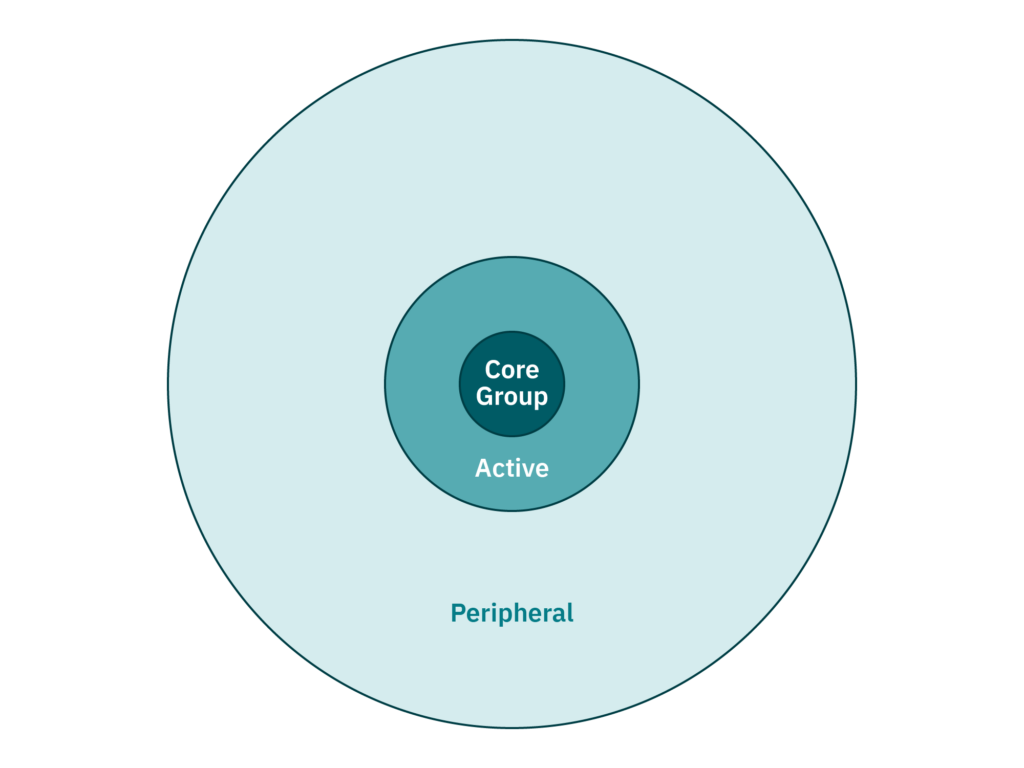
Communities of practice tend to encompass three degrees of participation: core, active, and peripheral members. Your leadership team is the core of the community and is therefore the most involved group. Leadership team members spend approximately five to ten hours per week on responsibilities like developing a community strategy, recruiting members, and engaging university administrators and faculty members.
The next level consists of active members—these are the people in committees who dedicate a few hours per week. Most of their time is spent on specific objectives, such as designing alternative protein courses, contacting researchers, or planning awareness-building events. The third level is composed of peripheral members who participate less frequently. Some of these individuals have limited free time, while others take longer to feel comfortable engaging more closely. Although they might only appear to participate a few hours per month, peripheral members are not as passive as they seem! Oftentimes, these members are quietly absorbing information and applying it in other spaces on campus.
Balance flexibility and accountability
Forcing everyone to dedicate ten hours per week will result in a less diverse community; students and researchers juggling jobs, families, and other commitments won’t feel able to participate. However, if a core member can only contribute one hour per month, others in your leadership team will have to take on extra work. Here are some ways to keep members accountable while being inclusive:
- Normalize moving through the different levels of participation. Students often assume you can only move in one direction: towards the core. When these students find themselves with less time to commit than anticipated, they tend to drop out of the community entirely rather than shifting into a less active role. Remind members that participation isn’t all-or-nothing; there’s no shame in stepping back, as long as the issue is communicated as soon as possible.
- Have regular check-ins with core and active members. Ask whether their current workload feels manageable and sustainable. If it doesn’t, work together to reassign tasks or rescope projects as needed. Even if they’re comfortable with their current responsibilities, encourage them to think seriously about their desired level of commitment in future years.
- As a leader, you can model this by asking yourself the same question. You will support the community most effectively if you transfer leadership–even temporarily–during a period of limited bandwidth rather than trying to push through the stress and schedule strain.
- Encourage members to be clear and realistic about their commitment. An active member should feel comfortable saying, “I’m picking up extra shifts at my job until February, so I’ll need to play a peripheral role until then. I can still review the proposal, but I won’t have the bandwidth to facilitate journal clubs. Once my work schedule is back to normal, I’ll be able to spend four hours per week on the research committee.”
Consider short-term appointments for some committee members. For the sake of continuity, core members (like the leadership team) should ideally hold their positions for a full academic year. The requirements for active members (like people in committees) can be more flexible. For example, a conference-planning committee might allow certain roles to last one to two months.
Offer ways to engage in public and private spaces
Vibrant, inclusive communities are designed with public and private spaces in mind. Public spaces include formal meetings, conferences, and websites, while private spaces refer to one-on-one interactions. Your community will get more value from public events when individual relationships are strong. People are more likely to engage as their authentic selves, ask for help, and contribute ideas. One way to catalyze individual relationships is to use the RandomCoffee feature on Slack, which randomly pairs community members each week.
Continuously measure and articulate value
To increase retention, communicate your community’s value
Because communities of practice are both time-consuming and voluntary, it’s critical to measure and articulate the value your community generates. The previous section on recruitment focused on delivering immediate, short-term value. To keep students and researchers engaged, it’s important to focus on long-term value.
Your community’s ability to help develop members’ alternative protein careers is one of the greatest sources of long-term value. We’ll explore this topic in more detail in the following section on fostering professional development.
Collect value-creation stories
Get in the habit of measuring value as you go. A simple system is to collect feedback in the form of value-creation stories. Invite members to answer the following questions and weave their responses into a narrative.
- What did the community do?
- What knowledge or insights did they produce?
- How were those insights applied to alternative protein ecosystem-building at your university?
A value-creation story from a specialized researcher might sound like this: “A member of the Alt Protein Project emailed me about applying my expertise to alternative protein science, which I had never considered. After meeting with them, I learned about GFI’s Research Grants Program and funding database. Since then, I’ve received funding for a new alternative protein research project.”
Share your findings within and beyond your community
Make sure these stories find their way back to community members, as this will help increase excitement and long-term engagement. As a bonus, value-creation stories can be a fun way to recognize members for their contributions. You can share these highlights during meetings or post them to a #smallwins channel on Slack. Lastly, you can use these stories to bolster your recruitment materials.
How to foster professional development
Fostering professional development is one of the key sources of long-term value in practice-based communities and therefore one of the most attractive benefits to prospective members. It’s especially important for emerging fields—like alternative proteins—where the absence of formal structures makes career development difficult to navigate alone.
Alt Protein Project groups offer their community members a supportive environment to learn and contribute knowledge and insights. With opportunities to pursue leadership roles and contribute to field-building activities, students are propelled to the forefront of the future food movement as thought leaders and subject matter experts. As a result, many Alt Protein Project alumni are working in the alternative protein field and starting their own companies.
This section lays out specific steps you can take to help your members prepare for careers in the alternative protein space. Much of this advice comes from students working to accelerate a different emerging field: ecological forecasting. For more tips on training yourself in an emerging field, check out these 10 simple rules written by students in the Ecological Forecasting Initiative.
Guide members to set career goals
Help members set goals and build learning plans
For students pursuing careers in more established fields like nursing, the learning plan is fairly straightforward: obtain a nursing degree. Since the alternative protein field has not yet developed standard curricula, preparing for a career in this space requires intentional goal-setting.
To help your community members get started, have each individual respond to the following questions:
- Why alternative proteins? Is there a particular research question that piques your interest? Is there a specific company or type of role you want to land?
- What specific knowledge and skills do you need to develop to achieve your goal?
- What education and training options are available to develop those skills? How much time is required to complete these learning opportunities?
Here’s how a specialized researcher and a field-builder might answer these questions:
TABLE
| Specialized researcher | Field-builder |
| 1. I’m drawn to complex, interdisciplinary scientific questions—specifically, improving flavor profiles through fermentation. | 1. I’m passionate about sustainability and I’d like to work in an entrepreneurial role. |
| 2. I have a background in biotechnology, but I need to dive deeper into food science and microbial diversity & metabolism. | 2. I need to understand the latest industry developments, learn about the science of alternative proteins, and gain experience working at a startup. |
| 3. In two semesters, I can complete courses on fermented foods and microbial diversity. I can also complete a two-week industry workshop on microbial fermentation. | 3. This month, I can complete GFI’s course on the science behind alternative proteins and read the state of the industry reports. Next semester I’ll focus on learning about startups and applying for summer internships. |
Remind members to revisit these questions periodically
It’s a good idea to reevaluate your answers to these questions each semester. Since this is a rapidly changing field, it’s possible your goals and interests may shift over time. Consider hosting regular career-building workshops where community members can share and reflect on their professional development plans.
Connect members to knowledge repositories
Use repositories to store information
Practice-based communities generate massive amounts of valuable information, but these learnings can get lost without an accessible storage system. Knowledge repositories help your community keep these lessons and insights organized.
Rather than having each university build separate systems, GFI maintains two knowledge repositories for the global Alt Protein Project community. The Alt Protein Project resource hub is a collection of guides to help you build alternative protein ecosystems at your university—this is a key resource for field-builders. We also manage an alternative protein teaching library of educational materials from alternative protein courses. Both field-builders and specialized researchers can use this repository for self-guided learning.
Explore our repositories

The alt protein student resource hub
Use this repository of helpful tools, templates, tips, and tricks to turn your university into an engine for alternative protein innovation.

Alternative protein teaching library
Bring more alternative protein content to the classroom using this hub of curriculum materials and resources for educators.
Encourage members to contribute
There are two main ways to use knowledge repositories for professional development. You can use them as learning tools, and you can add resources and insights to them. In emerging fields, contributing to knowledge repositories is especially impactful because many traditional educational resources don’t yet exist. Adding to an alternative protein repository is a great way to build career capital while increasing access to the field.
For instance, Lauren Blake from the Alt Protein Project at Johns Hopkins developed a lab protocol for the extraction of leghemoglobin (the ingredient that mimics blood in Impossible beef). After leading the workshop alongside other student leaders, Lauren made the protocol publicly available through our curriculum repository.
Another example comes from the Wageningen Alt Protein Project, where Aditya Vaze, Bernard Prasetyo, and Lai Hao Yang created a thesis guide to help students identify high-impact research opportunities. This is accessible to field-builders around the world through our guide to stimulating research at your university, which is part of our resource hub for the Alt Protein Project.
Helping members create learning plans
Suggest learning pathways with a range of time frames
At this stage, your community members have outlined their professional development goals and have familiarized themselves with knowledge repositories. They have clear objectives, but they also have a potentially overwhelming amount of educational resources to sort through. Your community of practice can help members identify learning pathways that fit their interests and time frames.
These educational pathways can feel informal compared to established degree programs, but from examining other emerging technologies, we’ve found peer-to-peer learning and other causal structures can be highly effective ways to train in rapidly-evolving fields.
Offer pathways to learn individually and in groups
For members with a preference for solitary learning, our open-access online course on alternative protein science is a fantastic starting point for newcomers to the alternative protein space. Encourage members who prefer social learning to start a study group; instead of completing this course asynchronously, they can complete one module together each week.
Journal clubs offer another great format for specialized researchers to learn in groups. Invite scientific researchers to meet on a weekly or monthly basis to discuss papers related to alternative proteins. Typically, one person selects a paper to read and presents a summary, and the other journal club participants can ask questions. Visit STEMCELL Technologies’ journal club guide for more tips and tools.
Point members to technical and non-technical curricula
Whether you’re interested in technical or non-technical future food careers, understanding the basic science behind alternative proteins is a must. However, advanced science is much more relevant to specialized researchers. Pre-existing curricula like the Alternative Protein Fundamentals Programme can be customized quite easily to incorporate topics and resources most relevant to these different audiences and more.
We also host two webinar tracks with leading subject matter experts from around the globe. The Science of Alt Protein seminar series is geared toward a technical audience, and The Business of Alt Protein seminar series addresses a commercially-focused demographic. Sign up for the next seminar on our events page or watch recordings of past events on our Youtube channel.
Provide pathways for different academic levels
Our website offers online resources for newcomers, experts, and everyone in between. Members who are brand new to alternative proteins can start with the essentials page, which offers a general overview of plant-based meat, cultivated meat, and fermentation. After learning the basics, we recommend reading the science pages featured below.
Explore the science behind alternative proteins

The science of plant-based meat
Learn about the science of plant-based meat. Discover resources and research on the latest technological developments and key scientific questions.

The science of cultivated meat
Learn about the science of cultivated meat and the challenges that must be addressed for commercial production.

The science of fermentation
Learn about the emerging role of microbial fermentation in building the next generation of alternative protein products.
Specialized researchers will benefit from even more advanced scientific explorations, such as this deep dive on cultivated meat cell lines. Each of these deep dives includes a reference table of relevant academic papers.
Dive deeper into alternative protein science and technology
Offer professional development opportunities
Communities are invaluable for building careers in nascent fields
As with any emerging field, the alternative protein space can be intimidating to navigate alone. Hosting career-building events like resume workshops and industry chats can help members reignite their motivation and feel more connected to the community. Several student groups have hosted career panels, including the Illinois Alt Protein Project and the Davis Alt Protein Project.
Your community should also provide members with networking opportunities. These can be valuable events to exchange knowledge and resources, find collaborators, and seek advice. For example, the Alt Protein Project at Johns Hopkins hosted a meet-and-greet with alumni working in the alternative protein space.
Take advantage of GFI-hosted events
You can also point your members to online events and networking opportunities. For members who want to learn more about pursuing careers in the alternative protein space, we offer a quarterly webinar called Ask GFI: Alt. Protein Careers. Participants can ask us questions and exchange insights with other job-seekers. Don’t forget to check our calendar of events for virtual networking sessions!
Connect with us
If you would like help growing the alternative protein ecosystem at your university, please reach out to the Alt Protein Project team. You can also share student testimonials or helpful tips for our global community of alternative protein ecosystem-builders.
Check out related resources

Laying the foundation for a strong student group
This guide will help you jumpstart your new student group, build leadership skills, maximize your impact, and keep your group operating effectively.

Collaborative Researcher Directory
Use this directory to find scientific collaborators in the alternative protein field.

Alternative protein career portal
Discover rewarding alternative protein jobs. Gain insights on building your career and find open positions in this exciting industry.

